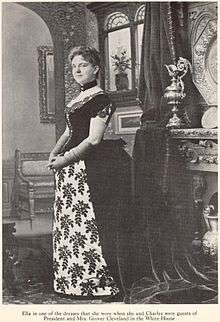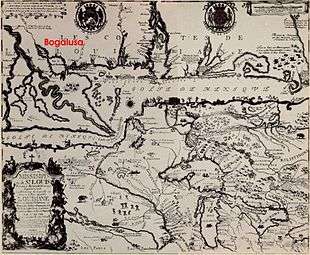Charles W. Goodyear
| Charles W. Goodyear | |
|---|---|
 | |
| Born |
Charles Waterhouse Goodyear October 15, 1846 Cortland, New York |
| Died |
April 16, 1911 (aged 64) Buffalo, New York |
| Resting place | Forest Lawn Cemetery, Buffalo |
| Occupation | President of the Great Southern Lumber Company and Buffalo and Susquehanna Railroad |
| Religion | Presbyterianism |
| Spouse(s) | Ella Portia Conger Goodyear |
| Children |
Anson Goodyear Esther Permelia Goodyear Charles Waterhouse Goodyear II Bradley Goodyear |
| Parent(s) |
Dr. Bradley Goodyear (1816-1889) Esther P. Kinne Goodyear (1822-1907) |
Charles Waterhouse Goodyear (October 15, 1846 - April 16, 1911) was an American lawyer, businessman member of the prominent Goodyear family. Charles, along with his brother, Frank, was the founder and head of several companies including the Buffalo and Susquehanna Railroad, Great Southern Lumber Company, Goodyear Lumber Co., Buffalo & Susquehanna Coal and Coke Co., and the New Orleans Great Northern Railroad Company. He was as a director of Marine National Bank, and of General Railway Signal.
Early life
Charles W. Goodyear was born in Cortland, New York on October 15, 1846, to Dr. Bradley Goodyear (1816-1889), who graduated from Geneva Medical College in 1845, and Esther P. Kinne Goodyear (1822-1907), whose ancestors came to the United States via Leyden, Holland, in 1635. Goodyear's birth was followed by his brother's Frank Henry Goodyear in 1849.[1] He was educated at Cortland Academy, Wyoming Academy, and in East Aurora, New York when his father was practicing medicine there.[2] As a boy, both Charles and Frank worked at Root & Keating's tannery.[1]
Career
Legal career
Goodyear moved to Buffalo in 1868 to study law in the offices of Laning & Miller, and later with John C. Strong. Goodyear was admitted to the New York State Bar Association in 1871 and began his own practice in Buffalo. His practice continued until 1875 until he formed a partnership with Major John Tyler, which continued for two years. From 1877 until 1882, Goodyear practiced alone until forming a partnership with Henry F. Allen (1837-1910)[3] under the name Goodyear & Allen.[2] When Grover Cleveland became Governor of New York State in 1883, he retired from the law firm of Cleveland, Bissell, and Sicard, at which point Goodyear joined, and the name of the practice became Bissell, Sicard & Goodyear. Goodyear continued to practice with Bissell, Sicard & Goodyear for the next four years.
Political career
From January 1, 1875, until October 1, 1877, Goodyear served as Assistant District Attorney under District Attorney of Erie County Daniel N. Lockwood, who was elected to the United States Congress in 1876 and who resigned the office of District Attorney in the autumn of 1877, whereupon Mr. Goodyear was appointed by Governor Lucius Robinson to fill Lockwood's unexpired term.[2]
Business career

Goodyear gave up the practice of law in 1887 to form a lumber company with his brother, Frank H. Goodyear, under the firm name F. H. & C. W. Goodyear. They invested in timberlands, lumber mills, coal, and railroads in Pennsylvania and New York.[4] They bought up large tracts of timberland that were considered inaccessible for harvest, because the lands were isolated and away from streams that were typically used to transport logs. They were able to access the timber by building railroad spurs as well as local sawmills to process the trees into lumber, which led to great financial success.[5]
They were the world's largest manufacturers of hemlock with an annual output of approximately 200,000,000 feet of hemlock, and nearly as much in hardwood. In the late 1890s as the lumber business expanded, Goodyear joined his brother's railroad, the Buffalo and Susquehanna Railroad which Frank had created in 1893 by the merger and consolidation of several smaller logging railroads.[6] When Goodyear joined, Frank stepped down as president of the railroad and assumed the positions of First Vice President and Chairman of the Board. Goodyear became Second Vice President and General Manager of the railroad, while Marlin Olmsted became President.

Between 1901 and 1905, the brothers purchased 300,000 acres of virgin yellow pine timberland in Louisiana and Mississippi near the southern end of the Pearl River.[7] In 1902, the brothers chartered the Great Southern Lumber Company in Pennsylvania[8] with their offices in the Ellicott Square Building in downtown Buffalo. The brothers began construction of the Great Southern Lumber Company sawmill, the largest sawmill in the world, in southeast Louisiana, and created the company town of Bogalusa, Louisiana where workers would live. To bring harvested trees to the sawmill and transport processed lumber to markets, the Goodyears established the New Orleans Great Northern Railroad,[9] which connected Bogalusa to the national railroad network.
In 1906, the brothers extended the Buffalo and Susquehanna Railroad from Wellsville to Buffalo, nearly 90 miles.[1] Unfortunately, Frank Goodyear did not live to see the sawmill completed as he died in 1907 of Bright's disease, shortly before the Panic of 1907.[7] the Great Southern Lumber Company sawmill began operation in 1908. Goodyear took over for Frank at the Buffalo and Susquehanna Railroad, among other companies they can, and William H. Sullivan was the General Manager of the Great Southern Lumber Company.
At various points in his career, Goodyear was President of the following associations: Goodyear Lumber Co., Buffalo & Susquehanna Coal and Coke Co., Buffalo and Susquehanna Railroad, Great Southern Lumber Company, and the New Orleans Great Northern Railroad Company, Director of the Marine National Bank, and General Railway Signal.[10]
Personal life


Goodyear married Ella Portia Conger (1863-1940), of Collins Center, New York on March 23, 1876.[10] The family lived at the Charles W. Goodyear House, built in 1903 by architect E.B. Green of Green & Wicks, at 888 Delaware Avenue in Buffalo. Together, the Goodyears had four children, all born in Buffalo:
- Anson Conger Goodyear (1877-1964), who married Mary Forman
- Esther Permelia Goodyear, (1881-?), who married Arnold Brooks Watson (1877-?)
- Charles Waterhouse Goodyear II (1883-1967), who married Grace Rumsey (1883-1963) in 1908. They divorced and in 1935, Charles married Marion Spaulding[11]
- Bradley Goodyear (b. 1885), who married Jeanette Bissell.
Goodyear, a member of the Presbyterian Church,[12] held office of trustee of the Buffalo Normal School, was organizing director of the Pan American Exposition, president of the Buffalo Club (in 1899),[13] trustee to the Buffalo Historical Society, on the board of The Buffalo Fine Arts Academy[14] and a delegate to Syracuse Convention.[10]
Among his close friends were U.S. President Grover Cleveland, as well as Cleveland's Secretary of State Daniel S. Lamont. He was widely considered instrumental in Cleveland receiving the nomination for President of the United States while Governor of New York. Goodyear and his wife were the first guests of President Cleveland at the White House.[4]
Goodyear died in Buffalo, New York in April 16, 1911[12] and is buried at Forest Lawn Cemetery, Buffalo[15] along with his father, mother, brother, wife, and son.
Frank H. Goodyear
Charles W. Goodyear's brother, Frank Henry Goodyear, married Josephine Looney in 1871. Frank had been working at Looneyville as a bookkeeper for Josephine's father, Robert Looney, a native of the Isle of Man. Looney ran a farm, sawmill, general store, and feed and grain business and owned vast timberlands in Pennsylvania. When her father died the next year, Josephine and Frank inherited the timberlands from her father's estate. Frank, who had already moved to Buffalo before Looney's death, used the inheritance to start the lumber business and enterprises that he, and eventually Goodyear, would run.[1] Josephine died in October 1915 of a heart attack at the Exchange Street Station. She was remembered as the benefactress of the convalescent home for children named after her in Williamsville, New York.
Gallery
-

The family tree continued to spread its branches.
-

Old French map: Directly below the left-hand coat of arms is the site near Pearl River of what was to become Bogalusa.
-

Charles W. Goodyear and Frank H Goodyear
See also
- Great Southern Lumber Company
- Buffalo and Susquehanna Railroad
- Anson Goodyear
- Charles W. Goodyear House
- Chip Goodyear
- Bogalusa, Louisiana
References
- 1 2 3 4 Dunn, Edward T. (2003). Buffalo's Delaware Avenue: Mansions and Families. Canisius College Press. pp. 360–362.
- 1 2 3 "Charles W. Goodyear House - History". buffaloah.com. Retrieved 3 September 2015.
- ↑ "Henry F. Allen". findagrave.com. Retrieved 3 September 2015.
- 1 2 Charles W. Goodyear Dead: active in business life, he aided in Grover Cleveland's nomination", New York Times—April 17, 1911. Retrieved 2015-9-3
- ↑ James Elliott Defebaugh. 1907. History of the Lumber Industry of America, Volume 2. The American Lumberman: Chicago. Retrieved 2013-11-23
- ↑ Pennsylvania State Archives http://www.phmc.state.pa.us/Bah/DAM/mg/mg457.htm
- 1 2 "Frank H. Goodyear Mausoleum". buffaloah.cm. Retrieved 3 September 2015.
- ↑ Great Southern Lumber Company Collection, LSU Libraries Retrieved 2013-11-20
- ↑ Mississippi Rails: New Orleans Great Northern Railroad Retrieved 2013-11-23
- 1 2 3 "Charles Waterhouse Goodyear". gravefinder.com. Retrieved 3 September 2015.
- ↑ LaChiusa, Chuck. "Ella Portia Conger Goodyear and Her Children". buffaloah.com. Retrieved 31 October 2015.
- 1 2 "Charles W. Goodyear" (Pg. 34). American Lumberman. April 22, 1911. Retrieved 10 September 2015.
- ↑ "Bogalusa Store". freepages.com. Retrieved 4 September 2015.
- ↑ "A. Conger Goodyear". albrightknox.com. Retrieved 3 September 2015.
- ↑ "Charles Waterhouse Goodyear". findagrave.com. Retrieved 3 September 2015.